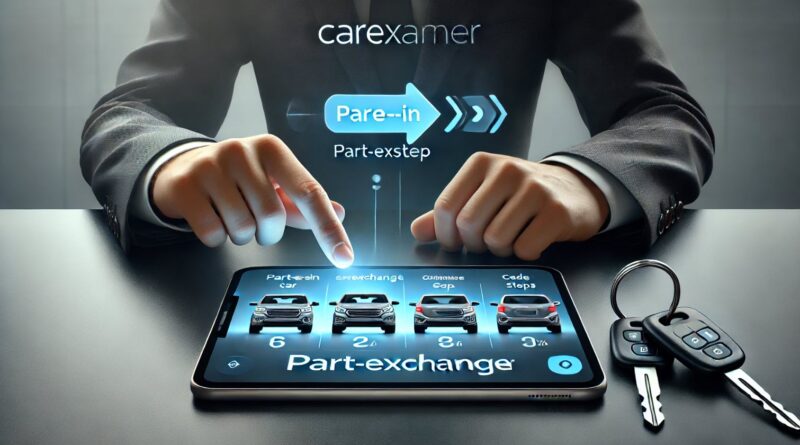How to Part-Exchange Your Car A Simple Guide
Here’s a straightforward guide how to part-exchange your car, from researching your car’s value to negotiating the best deal. If you’re thinking of upgrading your car, part-exchanging (or trading in) your current one can make the whole process a lot smoother. Essentially, part-exchanging lets you use the value of your old car to offset the cost of a new one—saving you the hassle of selling privately.
What Exactly Is Part-Exchanging?
It’s basically selling bellow market value usually at 20% discount. Part-exchanging means you’re handing over your current car to the dealer as part of the payment toward a new one. The dealer will value your car and apply that amount as a discount on your new purchase. It’s a popular option for buyers because it’s quick, convenient, and takes the stress out of trying to sell your car on your own.
Step 1: Research Your Car’s Value
Before heading to a dealership, it’s helpful to know roughly what your car is worth. Getting an accurate idea of your car’s value means you’ll be better prepared to negotiate. Here’s how to do it:
- Use Online Valuation Tools: Websites like Autotrader and Parkers can give you a general idea based on your car’s age, mileage, make, and model.
- Check Listings for Similar Cars: See what similar cars are selling for privately. Part-exchange values are often a bit lower, but it helps to have a ballpark figure in mind.
Step 2: Get Your Car Ready
First impressions matter, even when it comes to part-exchanges. Making sure your car is in good shape can positively impact the dealer’s valuation. Here’s what you can do:
- Give It a Good Clean: A clean car can show the dealer that it’s been well looked after, which might bump up the trade-in value a bit.
- Take Care of Minor Fixes: Small repairs, like replacing a bulb or topping up fluids, can make a difference without costing much.
- Gather Your Documents: Having your car’s service history, MOT certificate, and V5 logbook ready makes the process easier and can boost the car’s credibility.
Step 3: Shop Around for Quotes
Not every dealership will offer the same value for your trade-in, so it’s a good idea to get quotes from a few places before you make a decision. Here’s how to shop around:
- Visit Multiple Dealerships: Different dealers have different policies and needs, so getting multiple quotes can help you find the best offer.
- Look for Specialist Dealers: If your car is a specific make or model, a dealership specializing in that brand may give you a better offer.
- See If They’ll Match a Better Offer: If you find a higher offer elsewhere, let your preferred dealer know—they may match or even beat it.
Step 4: Negotiate Each Part of the Deal Separately
When part-exchanging, you’re both selling your old car and buying a new one, so it’s important to consider each part of the transaction. Here’s why separating the two can help:
- Keep Each Price Clear: By negotiating your trade-in value and the price of the new car separately, you can see where you’re getting a good deal (or not).
- Focus on Overall Savings: Sometimes a dealer may raise the trade-in value but not move on the new car price. Make sure you’re getting good value on both ends to maximize your savings.
Step 5: Choose the Right Timing
Timing can sometimes impact the offer you receive. Here are a few tips for when to make your trade-in:
- End of the Month or Quarter: Dealers often have sales targets, so you may find they’re more open to negotiation at the end of a month or quarter.
- Look for Promotions: Some dealerships run part-exchange promotions, which could mean bonuses or better deals if you trade in during a specific sale period.
Step 6: Finalize the Deal and Check the Paperwork
Once you’re happy with the part-exchange offer and the price of your new car, it’s time to finalize the deal. Here’s what to check:
- Review the Agreement: Double-check that the trade-in value and new car price match what was agreed upon.
- Confirm Any Extras: If you were offered extras like an extended warranty or free servicing, make sure these are included in the paperwork.
- Complete the Paperwork: The dealership will handle most of the ownership transfer details, but make sure you get copies of everything for your records.
Tips for Getting the Most from Your Part-Exchange
- Go In Prepared: Knowing your car’s market value puts you in a stronger position to negotiate.
- Don’t Be Afraid to Walk Away: If the dealer’s offer isn’t what you expected, don’t hesitate to walk away and explore other options.
- Be Upfront About Your Car’s Condition: Honesty about any issues is best—dealers will likely find them anyway, so being upfront helps avoid surprises.
Is Part-Exchanging Right for You?
If you value convenience and speed, part-exchanging is a great option. It’s an ideal choice if you don’t want the hassle of selling privately and want a quick, smooth transition to a new car. But if getting the highest possible price is your priority, you may want to consider selling privately instead.
Take the time to weigh your options and consider what’s most important to you. By shopping around, negotiating confidently, and keeping these tips in mind, you can feel good about the part-exchange deal you’re getting.
Final Thoughts
Part-exchanging your car is an easy way to save on the cost of a new car while avoiding the challenges of a private sale. With a little preparation and research, you’ll be ready to negotiate a fair trade-in value and drive away happy with your new vehicle.
Buying a used VW. Buying used vauxhall, BMW, Jaguar, Ford, Volvo, Range rover, Bentley, Aston Martin, Porsche, Ferrari, Lamborghini, Maserati, Hyundai, Tesla, Honda, Pagani

